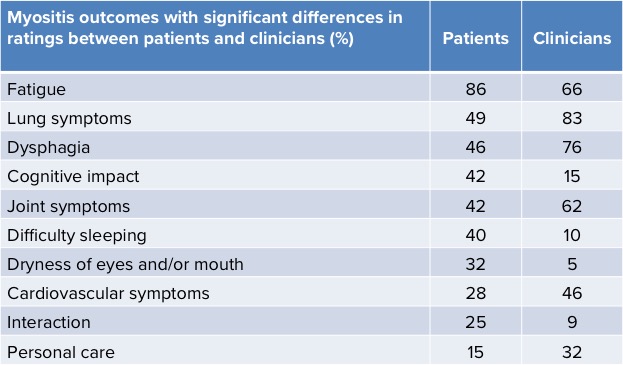Big differences exist between clinicians and myositis patients in perceptions of the most troublesome aspects of the condition, a study by Outcomes Measures in Rheumatology (OMERACT) group shows.
While clinicians nominate muscle, skin and joint symptoms and dysphagia as the most important outcomes for myositis, they tend to overlook domains such as fatigue, cognitive impact and difficulty sleeping that are ranked as most troublesome by patients.
The findings come from a survey of 510 patients and 101 clinicians, including participants and neurologists recruited by the Myositis Association of Australia. The Australian investigator in the trial was Professor Merrilee Needham, head of Neurology at Fiona Stanley Hospital, Perth.
While showing agreement between clinicians and patients in some myositis domains such as medication side effects and ability to work, the results from patients in 40 countries were remarkably consistent in prioritising symptoms that reflect their lived experience of disease.

The prominence given to cognitive outcomes by patients might appear counterintuitive for a muscle disease but it could reflect poor sleep quality and fatigue, according to lead author Dr Christopher Mecoli from the Johns Hopkins University School of Medicine.
Writing in the Journal of Rheumatology, he noted that similar high ranking for cognitive problems was seen in patients with rheumatoid arthritis and may also be related to a wider systemic inflammation.
Other symptoms varied with the diagnosis, with skin predictably rating highly in dermatomyositis whereas patients with polymyositis rated muscle symptoms and difficulty with leisure activities higher.
Dr Mecoli said the findings will be used by OMERACT’s Myositis Special Interest Group (SIG) to develop better outcome measure instruments that more accurately reflect the symptoms that matters to patients.
“These data will allow for the education of healthcare professionals to better understand the life effect of patients with idiopathic inflammatory myopathies.
“It is hoped that having these differences highlighted also will make it more likely that healthcare professionals will endorse and use the patient-reported outcome measures that result from this work.”